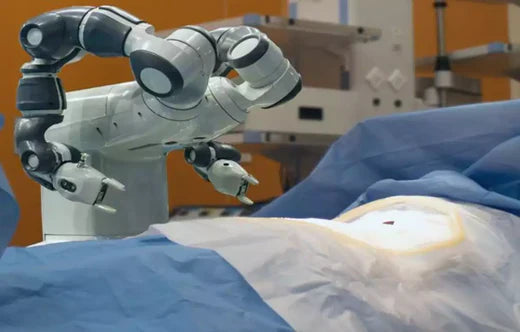
The Future of Healthcare: Medical Robotics Leading the Way
Share

Introduction
The healthcare industry is in the midst of a groundbreaking transformation, and at the forefront of this change is medical robotics. These technological innovations are not only enhancing precision and accuracy in procedures but are also driving a new era of care that prioritizes personalized and efficient treatments. From surgical robotics to robot-assisted rehabilitation, AI integration, nanorobotics, and elderly care, the evolution of medical robotics is reshaping the way healthcare is delivered. According to Next Move Strategy Consulting, the medical robotics market was valued at USD 45.04 billion growing at a CAGR of 17.1% by 2030. This rapid growth presents lucrative opportunities for investors looking to engage with a technology poised to revolutionize healthcare.
Surgical Robotics: Precision Meets Innovation
Surgical robotics has undergone significant advancements, revolutionizing the way surgeries are performed. Traditional surgeries often involved large incisions, lengthy recovery times, and significant risk. Today, robotic systems offer highly precise, minimally invasive procedures that not only reduce the risk of complications but also shorten recovery times for patients.
Robotic systems, like the da Vinci Surgical System, have enhanced the dexterity and flexibility of surgeons, allowing them to perform complex procedures with extreme precision. These robotic-assisted surgeries promise less invasive interventions, improving patient outcomes and reducing healthcare costs. For investors, the growing demand for these technologies marks an excellent opportunity to capitalize on the future of minimally invasive surgery and robotic innovations in healthcare.
Robot-Assisted Rehabilitation: Revolutionizing Recovery
Medical robotics is also making a significant impact in rehabilitation therapies. The rise of robotic exoskeletons and rehabilitation robots is helping patients recover from injuries and surgeries more quickly and effectively than ever before. These systems provide adaptive support, tailored to the specific needs of each patient, enhancing traditional rehabilitation methods.
For individuals with neurological impairments or severe musculoskeletal injuries, robotic rehabilitation technologies are making recovery more efficient and improving patient outcomes. The integration of robotics into rehabilitation therapy is a game-changer, and as demand for these services increases, the market for robotic rehabilitation systems is expected to grow significantly. For investors, this represents a promising avenue to support both medical technology and rehabilitation innovation.
AI Integration: Smarter Robotics for Better Healthcare
One of the most exciting trends in medical robotics is the integration of artificial intelligence (AI) and machine learning (ML). These technologies empower robots to analyze complex data and adapt to dynamic environments during medical procedures. As robots become smarter, their ability to make data-driven decisions improves, enhancing the precision and personalization of healthcare interventions.
For example, the Canady Robotic AI Surgical System, launched in September 2023, integrates AI with robotic surgery to optimize surgical outcomes. The combination of AI and robotics has the potential to unlock new levels of precision and efficiency in surgery, further enhancing the capabilities of healthcare providers. As AI continues to advance, the integration of these technologies into the medical robotics space will drive even greater demand for intelligent surgical systems, presenting a high-growth opportunity for investors.
Nanorobotics: Transforming Medicine at the Cellular Level
Nanorobotics represents one of the most promising frontiers in healthcare technology. This innovative field focuses on creating microscopic robots that can navigate the human body and perform tasks at the cellular level. These tiny robots hold the potential to deliver drugs, perform precise surgeries, and collect diagnostic data, all while minimizing the invasiveness of procedures.
Nanorobots could revolutionize medical interventions by providing highly targeted and efficient solutions for treating a range of diseases, from cancer to cardiovascular conditions. The ability to perform cellular-level surgeries could lead to more effective treatments with fewer side effects, improving patient outcomes and reducing recovery times. As research in nanorobotics advances, this technology is poised to become a cornerstone of precision medicine, creating a wealth of opportunities for investors in this emerging field.
Robotics in Elderly Care: Enhancing the Quality of Life
With the global population aging rapidly, the role of robotics in elderly care is becoming increasingly important. Robots are being developed to assist older adults in leading more active, engaged, and independent lives. From companionship robots that address social isolation to assistive technologies that help with daily tasks, robotics is playing a critical role in improving the lives of seniors.
In particular, the focus on alleviating loneliness and social isolation in elderly populations has gained significant attention. These robots help provide emotional support, monitor health conditions, and assist with mobility, all of which contribute to a higher quality of life for aging individuals. As the demand for elderly care solutions continues to rise, particularly in home settings, investing in robotics for elderly care offers significant growth potential in an expanding market.
Conclusion: A Bright Future for Medical Robotics
The future of healthcare is being shaped by the rise of medical robotics, which is poised to transform surgical procedures, rehabilitation therapies, AI integration, nanorobotics, and elderly care. These technologies are making healthcare more precise, efficient, and personalized, ultimately improving patient outcomes while reducing costs.
With the medical robotics market projected to grow from USD 14.92 billion in 2023 to USD 45.04 billion by 2030, the potential for investors is enormous. From cutting-edge surgical systems to robot-assisted rehabilitation, AI-driven diagnostics, and nanorobotics, the opportunities are vast for those looking to capitalize on this rapidly evolving sector.
As medical robotics continues to advance, these technologies will become even more integrated into everyday healthcare, driving better care, improving lives, and creating exciting investment opportunities. Now is the time for investors to get involved in a market that will define the future of healthcare.